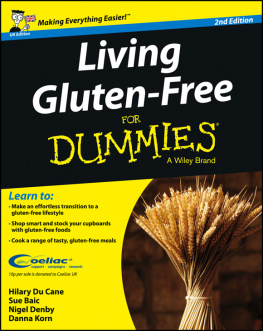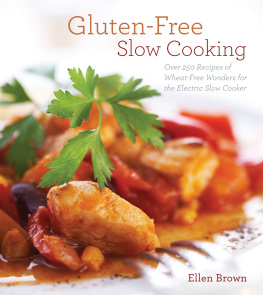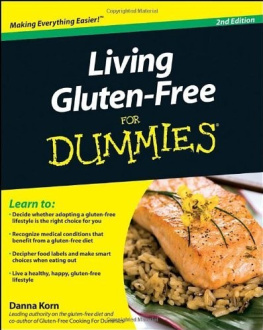Contents
PREFACE
C hristmas means visions of sugarplums and allowing cautious eating to take a holiday in order to savor each and every sugarplum. But for the millions of people for whom eating gluten, a natural protein found in wheat flour, is tantamount to munching poison, thats hardly the case. They have to be vigilant about every morsel they put in their mouths every day of the year.
Theres no magic wand that can be waved over a baked good to make it free from gluten, nor is there any one product that can replace wheat flour on a one-to-one basis. But with just a few ingredientsall of them totally natural your cookies can be as delicious as any made previously with wheat flour but with one exception: everyone you love can now enjoy them. No one is a second-class citizen who has to be told, These arent for you.
And what delicious treats youll find in this book! All of the basic groups of cookiesfrom crispy sugar cookies that can be decorated with icing and candies to easy-to-make bar cookies and classic drop cookiesare all included. In addition are some cookie forms, such as meringues and macaroons, which have never contained gluten. These are great cookies to make for gluten-intolerant people if you dont want to buy special flours and starches.
The book ends with a chapter on gluten-free candies. These dense nougat and fudge treats are also part of Christmas celebrations, and they can be made on top of the stove while the oven is filled with trays of cookies.
If youve been baking gluten-free goodies for years, I hope youll find some new recipes here to tantalize family and friends. But if youre new to the world of recipes calling for rice flour and potato starch instead of all-purpose flour, youll find some useful guidance on the hows and whys of gluten-free baking to help you convert cherished family favorites to a gluten-free regimen as well as finding new recipes everyone will enjoy.
Christmas is a time of giving, and what could be a better gift to those who must eliminate gluten from their diets than a feast for their eyes and their tummies.
Happy baking!
Ellen Brown
Providence, RI
INTRODUCTION
No Grain, No Pain
U nderstanding the need to live gluten-free starts with understanding how gluten can cause life-threatening problems if not removed from the diet of those who cannot tolerate it. But the good news is that following a gluten-free diet can mitigate debilitating symptoms and pain in as little as a few monthsusing food and not a pharmacy.
Our bodies contain a complex and interlocking system to prevent harm. There is a network of organs, glands, and cell types that are lumped under the heading of the immune system that are all dedicated to warding off illness. But sometimes the immune system has been mysteriously programmed incorrectly and attacks healthy cells rather than potentially harmful ones. These maladies are termed autoimmune diseases . And though not fully understood, many medical professionals agree that the sources of autoimmune disorders include viruses, which change the information carried inside the cells; sunlight and other forms of radiation; certain chemicals; and drugs. There may also be a link between autoimmune diseases and sex hormones since many more women suffer than do men.
There are more than eighty types of autoimmune disease, and they include lupus, rheumatoid arthritis, and Graves disease. (Some medical authorities also believe that multiple sclerosis is caused by an autoimmune response.) While the aggravating factors in many of these diseases are complex, in the case of celiac disease it is really rather easy. Celiac disease is caused by an autoimmune response to gluten, one of the thirty proteins found in wheat, barley, and rye.
Humans as a species are unable to properly digest the gluten protein. Normal protein digestion involves a complete breakdown of protein into small particle called amino acids that are in turn absorbed by the small intestine and used by the body as a nutritional source. Those without gluten intolerance dont appear to be affected negatively by the inability to properly digest gluten in the way those with gluten intolerance are.
But for those who are intolerant, the undigested gluten protein gets absorbed into the lining of the small intestine but is not seen by the body as a source of nutrition. To the contrary, the bodys immune system attacks these protein particles as something that needs to be destroyed, in very much the same way as it would attack an invading organism such as a virus, bacteria, or parasite. This causes inflammation and damage to the small intestine, which prevents it from absorbing the nutrients your body needs to remain healthy.
Normally, the small intestine is lined with tiny, hair-like projections called villi that resemble the deep pile of a plush carpet on a microscopic scale. It is these villi that work to absorb vitamins, minerals, and other nutrients from the food you eat. Without prominent villi, the inner surface of the small intestine becomes less like a plush carpet and more like a tile floor. The body is unable to absorb nutrients necessary for health and growth, so malnutrition results.
It is now clear that the disease is far more common than doctors once believed. New research reveals that celiac disease may be one of the most common genetic diseases, and one federal study estimates that 1 in every 133 Americans suffers from it. Thats more than 3 million people.
The condition is diagnosed by testing for three antibodies anti-gliadin , anti-endomysial , and anti-tissue transglutaminase all of which are present when an affected person is exposed to gluten, but disappear when the offending grains are no longer consumed.
But there are millions more people whose digestive problems dont fall under the strict definition of celiac disease (because they do not test positively for the antibodies), but who have found that following a gluten-free diet helps them. Rather than calling them gluten-intolerant, theyre termed gluten-sensitive, and this group could include up to thirty percent of the American population.
For this much larger group, removing gluten can eliminate symptoms ranging from abdominal pain to osteoporosis and sinus congestion. Gluten-sensitivity has also been linked to conditions such as psoriasis, anemia, and asthma.
Following a gluten-free diet is not a temporary measure to ameliorate a condition. Its for life. Eliminating gluten doesnt cause the body to become less sensitive to it. The condition will return as soon as gluten is reintroduced to the diet.
But these days, following a gluten-free diet is easier than ever before. According to a study released in 2009, the market for gluten-free products grew at a compound annual growth rate of 28 percent from 2004 to 2008, capturing almost $1.6 billion in retail sales during 2008. Its anticipated that by 2012 the market will reach $2.6 billion in sales.
This increase in gluten-free foods makes it possible to find the ingredients needed for the delicious cookies in this book in general supermarkets rather than health food specialty shops. The recipes were formulated so that everyone will love them, and for those on a gluten-free diet it means they can enjoy sweet treats again.





















